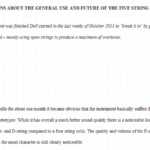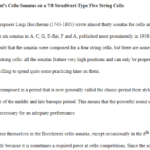Playing the Suite BWV 1012 on a 7/8 Stradivari-Type Five String Cello
After completing two prototypes and deciding about fingerings and bowings, many hours of practicing lead to several conclusions about the question what kind of instrument the suite was originally composed for.
Since there is no doubt that the suite was written for a five string instrument those conclusions were based on the answer to the question if it is possible to conveniently render the full text of the suite BWV1012 on a five string Stradivari-size cello as opposed to a smaller instrument. A very important aspect for arriving at a correct answer is the fact that the use of the thumb was not yet introduced at Bach’s time as a technique of playing the cello.
Another important point is the fact that in the baroque era there have been other, smaller cello types, equipped with up to six strings, most of them chin/arm-held.
Prélude
Points suggesting that the suite should be performed on a five string instrument:
Bach used in his cello suites frequently the technique of Bariolage. (See Glossary.) This technique involves the use of an open string for an accompaniment which separates itself from the melodic progression on another string. (See also Suite 1006; Prélude; M.33 and following.) It is crucial that the separate notes are played on the different, open string; otherwise the melody cannot be properly recognized. Using a five string cello all bariolages can be realized as intended.
The long sixteenth passage starting in M.85 can be played in one single position on a five string instrument.
M.102 can be played without using the thumb.
Points suggesting that the suite should be performed on a small, possibly chin/arm-held instrument:
One place suggests the use of the thumb (MM.21/22) and one place requires the use of the thumb (MM.70-76). Since the thumb was not yet used as a playing finger when the work was composed, it is safe to assume that the work was written for a much smaller instrument.(Other places within the six suites, for example the Menuet I of the Suite 1008 and the Préludes of the Suites 1009 and 1010, which request the use of the thumb, require unusually frequent shifts or extreme strechts, even when using a five string cello, indicate that all the suites were composed for a rather small instrument.)
Highest note on a five string Stradivari-type cello is the g’’ in the the 8th position of the E-string (M.74).
Allemande
Points suggesting that the suite should be performed on a five string instrument:
The Allemande not once requires the use of the thumb or unusual amounts or types of shifts when executed on a five string instrument. The whole movement can be performed quite comfortably within the lower four positions on a five string Stradivari-size cello.
The Allemande resembles many movements of the violin sonatas and partitas in its intricate beauty which will be lost if performed on a four string cello.
Points suggesting that the suite should be performed on a small, possibly chin/arm-held instrument:
There are no major points concerning this movement. Some small shifts could be saved but once getting used to the additional string any serious four string cello player could play this movement quite soon beautifully on a five string cello.
Highest note on a five string Stradivari-type cello is the d’’ in the the 4th position of the E-string (M.3)
Courante
Points suggesting that the suite should be performed on a five string instrument:
The Courante also does not require the use of the thumb if played on a five string cello.
On a four string cello the execution of the Courante requires a number of shifts to very high positions. Those shifts turn on a five string cello mostly into string changes which can be mastered much more easily.
Highest note on a five string Stradivari-type cello is the b’ in the 2nd position of the E-string (MM.3/26/40).
Points suggesting that the suite should be performed on a small, possibly chin/arm-held instrument:
As with the Allemande there are no major reasons not to perform the Courante adequately on a five string Stradivari-sized cello.
Sarabande
Points suggesting that the suite should be performed on a five string instrument:
The Sarabande is one of the most difficult movements within the suite(s) to be performed on a four string cello. Many of the chords have to be split into different positions, such disturbing a melodious performance. Generally a quite unique technical approach becomes necessary, very unusual even when using common modern cello techniques-techniques yet unknown to cellists of the baroque era.
The Sarabande of the Suite BWV 1012 presents cellists with tremendous technical problems, some of them unsolvable when using a four string instrument; a fact that certainly suggests that it should be performed on an instrument equipped with five strings.
Highest note on a five string Stradivari-type cello is the c’’ in the 3rd position of the E-string (MM.13/14).
Points suggesting that the suite should be performed on a small, possibly chin/arm-held instrument:
Most of the chords can be performed in low positions on a five string Stradivari-cello.
The Sarabande can be properly performed with some minor difficulties on a five string Stradivari-sized cello, but it could be performed more easily on a smaller five string instrument: There is one place which requires changing positions within one single double stop (M.6; half position to 2nd position). That is not a technique used by cellists of the baroque era. The use of a smaller five string instrument would eliminate that problem.
Gavotte I
Points suggesting that the suite should be performed on a five string instrument:
All chords can be performed in the first four positions; the use of the thumb is not necessary.
Highest note on a five string Stradivari-type cello is the b’ in the 2nd position of the E-string (MM.3/10/23/26).
Points suggesting that the suite should be performed on a small, possibly chin/arm-held instrument:
There is one place which requires changing positions within one single double stop (M.17; half position to 1st position). The chord requires either a shift or some unusual stretching; both are techniques that were not commonly used in the baroque era.
Gavotte II
Points suggesting that the suite should be performed on a five string instrument:
The piece can be performed throughout in conveniently low positions, which guarantee optimal acoustic conditions.
Highest note on a five string Stradivari-type cello is the a’ in the 5th position of the A-string (MM.14/18).
Points suggesting that the suite should be performed on a small, possibly chin/arm-held instrument:
There is one place (M.17) where within a double stop a shift or big a stretch is necessary. Otherwise playing this Gavotte on a smaller, chin-held instrument would not result in a significant advantage.
Gigue
Points suggesting that the suite should be performed on a five string instrument:
Using a five string cello most of the frequent shifts that are necessary on a four string cello become string changes, which are much easier to be mastered. (This can be done by looking at the bow and the relevant string; a technique that is not necessary using a four string cello. On a five string cello correctly locating the lower three strings is rather difficult.)
Highest note on a five string Stradivari-type cello is the d’’ in the 4th position of the E-string (M.51).
Points suggesting that the suite should be performed on a small, possibly chin/arm-held instrument:
There is one place which requires the use of the thumb or some unusual stretching. (M.65; 4th to 3rd position) As mentioned before, those are techniques not commonly used in the baroque era.
CONCLUSIONS CONCERNING BWV 1012
Using a four string cello for playing the suite BWV 1012 presents a modern cellist with many technical and musical problems that are highly untypical for the baroque period. Those difficulties make a natural and correct performance problematic; even the most advanced players have to compromise – it is not possible to play the piece in its whole as it was composed.
Even when taking some possible sound loss into account the use of a Stradivari-type five string cello is the most recommendable way for cellists to approach the Suite BWV 1012. Especially smaller models, like the 7/8- sized instruments built during this project, seem to be most appropriate for such a purpose. There still are some few places where the use of modern techniques is necessary, but there would be no major compromises performing the suite by any professional cellist who is willing to invest a reasonable amount of practicing time.
The remaining crucial question is whether the possibly costly investment in purchasing such an instrument in order to perform one single piece of music is reasonable. Further research will strive to answer the question if there might be other compositions suggesting the use of a five string cello.
However, the ideal instrument for performing the Suite BWV 1012 would be a rather small, five string chin/arm-held instrument, used by viola players or violinists. In the recent past the most popular instrument of this kind became the Viola da Spalla as described by D. Badiarov. (See D. Badiarov’s documentation.)



